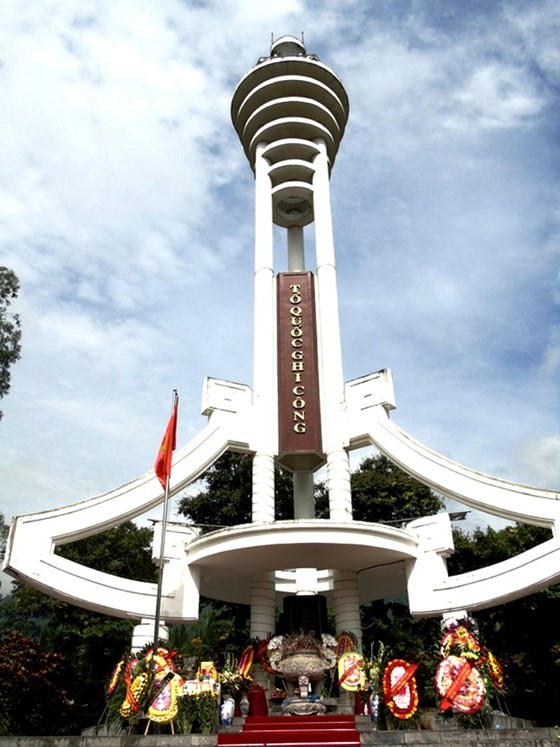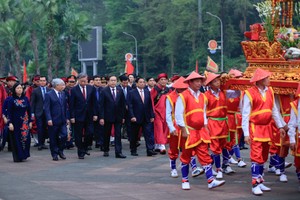
Lot of questions and suppositions related to Vi Xuyen front as well as the mortal combat by Vietnamese military and soldiers to protect the country’s territory have not been satisfactorily answered because of many reasons. Vi Xuyen is a border mountainous district in Ha Giang province.
Nearly decade of unceasing gunfire
In the memory of Vietnamese, February 17, 1979 is an unforgettable date when China mobilized over 600,000 troops together with 2,558 ground cannons, 550 tanks, 676 airplanes and two anti-aircraft artillery divisions dividing into two directions to suddenly start the invasion along the northern border line of Vietnam. On the first day of the fight, Vi Xuyen was hot with Chinese troops’ bombardment and attacks.
After over ten days implementing the intention of launching fast attack to fast capture targets according to initial plan, Chinese troops based on their advantages in troop strength and modern weapons to penetrate tens of kilometers into Vietnam’s territory in some directions. However they failed to move further inland and the fighting situation was drastically long lasting in the area.
Under the pressure of domestic and international public opinions and suffering heavily damaged force, the Chinese army was forced to withdraw from Vietnam to prevent from getting stuck in the mud of the war.
On March 18, 1979 Chinese troops basically retreated according to plan. Yet peace was not restored in the northern border line especially in Vi Xuyen front.
It could be said that nearly ten years after March 18, 1979, gunfire never stopped as mortar shells from the other side of the border were kept pouring into Vi Xuyen.
From a secondary area, Vi Xuyen quickly became a hot spot and a front in the rodent policy of triggering border conflicts by the Chinese army at that time.
Why it was Vi Xuyen
Along thousands of kilometers of the border line, China chose Vi Xuyen as a point of invasion after the war they called “To teach Vietnam a lesson” ended.
Firstly, Vi Xuyen has some spots where border planning was unclear. They comprise Height 1509 which China called Lao San and Height 1250 which China called Gia Jia Yin San. Attacking Vi Xuyen, Chinese troops had a reason for their actions of launching the war, duped Chinese people and coped with international opinion.
Secondly, the Chinese army aimed at luring Vietnamese combat force to the border line as many as possible to weaken the country and Vi Xuyen was the ideal area to implement the intention.
Thirdly, China was afraid that the war will spread, break out again and affect the Four Modernizations program of the country. Creating the hot spot at Vi Xuyen not only attracted Vietnamese combat force, forced Vietnam to adjust strategic layout and maintain a large standing army in a non-key area, far from the rear and difficult to ensure logistics; but also not affected the Four Modernizations program.
Firing Vi Xuyen, the opposing side gained initiative in time, space and scale as well as force and intensity to conduct attacks. It can be said that Vi Xuyen military and residents preceded and returned later in the northern border defense fight.
Since the first days of the fight, local armed force unyieldingly held out to fight, break, push back tens of the assaults by Chinese troops and hold defensive battlefield steadily.
Specially, the fight on March 13, 1979 stopped an assault by two battalions of the enemy in the defense area of Regiment 122 and Ha Tuyen province’s Lao Chai.
Vi Xuyen epic
Vi Xuyen Front was actually fierce since mid-1984. Many experienced units were mobilized to Vi Xuyen to take turns protecting important locations and take back spots encroached by the Chinese army. During peak time, up to nine major divisions attended the combat in Vi Xuyen.
On July 12, 1894, Vi Xuyen military and residents opened a big attack to take back Heights 1030, 233 and 685 and Altitudes 300 and 400 west of the Lo River. In spite of failing to reclaim all the above strategic spots, soldiers of Regiment 174 under Division 316, Regiment 876 under Division 356 and others units struggled very bravely. Nearly 600 soldiers of Division 356 laid down. That was one of the fiercest battle with the largest casualties in Vi Xuyen front in the 1980s.
From November 1984 to early 1985, the fight was even more violent than before as the two sides fought for every meter of land, brush and small cave in the mountain.
Chinese troops took advantage of high terrain in mountains, troop strength and firepower of artillery to continuously attack Height 1509 and other strategic locations such as Dai Hill and Co Ich Hill. Still these attacks all were broken by Vi Xuyen residents and military.
Despite high casualty rate, soldiers neither balked nor withdrew but transferred into implementing defense posture. The two sides were only few meters apart from each other somtimes.
Vietnamese soldiers must fight in deprivation and miserable situation but they still hold the battlefield steadily. A person was given three balls of cooked rice to serve with dried fish or salt. Three people received a five liter can of water a day.
Continuously from May 31 till June 16, 1985, Chinese troops used artillery to bombard Vi Xuyen regardless of day and night and organized 21 counterattacks to gain control over Height A6b, an advantageous location that Vi Xuyen military and residents had just taken back. Still all the counterattacks were stopped.
From September 23-25, A Chinese army corps continued opening an attack in the area from the east to the west of the Lo River, focusing on Co Ich Hill and Height 1,100 in Vi Xuyen. In the end it was also defeated.
The fighting in Vi Xuyen front did not abate in 1986 when the land must suffer 50,000 shells from the other side of the border. The enemy launched as many as seven attacks to Dai and Co Ich Hills areas.
Local forces were still calm to resist and fail the attacks one by one. Entering 1987, the Chinese army halted Vi Xuyen encroachment attacks. However the land kept experiencing shelling until the end of 1988. Early 1989, Chinese troops withdrawn from 20 spots they encroached in Vietnam’s territory in the northern part of Vi Xuyen.
In the fight to protect the country in the northern border, nearly 5,000 Vietnamese military officials and soldiers laid down. Of these the remains of over 1,700 soldiers have been found while the remaining of 3,000 scattering somewhere in caves, under tree roofs and by steep mountain sides have not been found.
























